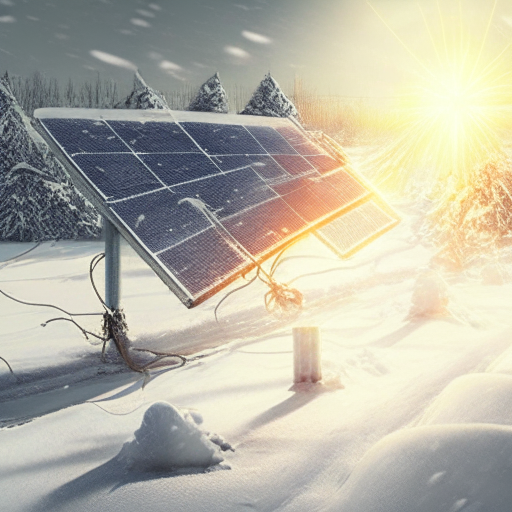Harness the Power of Solar Energy for Survival in Extreme Cold Weather
As a committed survivalist, you are undoubtedly aware of the critical need for achieving self-sufficiency, particularly when confronted with the formidable challenges posed by severe winter weather. One of the foremost concerns you will face is the effective utilization of renewable energy sources in frigid conditions. While the cold can appear to be a significant barrier, there is no cause for alarm! In this article, we will explore the untapped capabilities of solar power in cold climates. Our aim is to share practical strategies that will enable you to efficiently harness solar energy, even amidst the harshest winter conditions, by adopting a proactive and well-informed approach to your energy needs.

It is a common misconception that solar electricity is only viable in warm, sunny environments. Thanks to remarkable advancements in technology, it is now entirely possible to capture solar energy even in colder climates. Let us delve into the various techniques that empower solar power systems to thrive in extreme cold and examine how you can utilize this sustainable, eco-friendly energy source to significantly enhance your lifestyle and survival strategies. By understanding these methods, you can transform your approach to energy use, ensuring that you remain self-sufficient regardless of the weather.
First and foremost, grasping the fact that solar panels generate energy from sunlight rather than warmth is essential. While lower temperatures may impact the efficiency of solar panels, they do not render them ineffective during winter months. By engaging in strategic planning and innovative techniques, you can enhance your solar power system’s performance, ensuring optimal operation even in the coldest environments. Understanding how solar panels function across varying temperatures will empower you to make informed decisions that effectively meet your energy demands, allowing you to maximize your solar investment year-round.
One critical factor for optimizing solar electricity generation in cold climates is the angle and orientation of your solar panels. Proper alignment can dramatically increase the amount of sunlight your panels capture throughout the day. During winter months, the sun’s path is lower in the sky, making it essential to tilt your panels at a steeper angle. This adjustment facilitates maximum sunlight capture, thereby significantly enhancing their efficiency. Furthermore, positioning the panels to face south can further augment their sunlight collection capabilities, which is particularly advantageous during the shorter days of winter, ensuring that you get the most out of your solar setup.
Snow accumulation poses another significant challenge in colder regions that can inhibit the effectiveness of your solar panels. A thick blanket of snow can drastically reduce electricity output. However, by proactively addressing this issue, you can discover effective solutions. Consider installing snow barriers or heating elements on your solar panels to prevent snow buildup. These enhancements not only assist in melting existing snow but also ensure continuous energy production, even during snowstorms. Additionally, regularly clearing snow manually can serve as an effective maintenance strategy, keeping your panels functioning optimally and free from obstructions while maximizing energy output.
Implementing robust battery storage systems is a forward-thinking strategy that can significantly enhance solar power efficiency in cold conditions. These batteries are essential for storing surplus energy generated during daylight hours, allowing you to rely on this energy when sunlight is scarce or temperatures drop. The importance of battery storage is especially pronounced in freezing conditions, as it guarantees a consistent supply of electricity when you need it most. By investing in a high-quality battery system, you can maintain your energy independence and be well-prepared for unforeseen circumstances that may arise during severe weather events, ensuring a stable energy supply even in challenging times.
Selecting the appropriate type of solar panels is vital for optimizing your solar energy system’s efficiency in cold climates. Certain panels are specifically engineered to perform better at lower temperatures and may incorporate enhanced insulation or specialized materials to minimize the adverse effects of frost and ice on their performance. By making an informed decision regarding the panel types that best suit your cold environment, you can maximize energy production and ensure that your solar power system effectively meets your energy requirements, providing you with the resilience needed for survival in harsh conditions.
Beyond the technical aspects, ensuring that your solar power system is installed by professionals experienced in cold climate conditions is essential. Skilled installers can offer best practices for installation, ongoing maintenance, and troubleshooting, providing invaluable insights into optimizing your system. Their expertise will help guarantee that your solar setup operates at peak efficiency, even under the most challenging winter circumstances, ultimately enhancing the reliability of your energy source and giving you peace of mind during critical situations.
Maintaining a proactive and prepared mindset is crucial in survival scenarios. While solar power can serve as a dependable and effective energy source in cold climates, having backup generators or alternative energy solutions is paramount. These additional measures act as a safety net in case of prolonged periods of low sunlight or unexpected system failures. By integrating solar power with other renewable energy sources, you can further enhance your energy independence and resilience, ensuring that you are well-equipped to tackle any weather-related challenges that may arise and sustain your survival efforts.
Solar energy holds tremendous potential even in the coldest climates, provided it is strategically planned and technically advanced. By adjusting your panel angles, mitigating snow accumulation, incorporating battery storage, selecting appropriate solar panels, relying on skilled installation, and developing contingency plans, you can unlock the full potential of solar energy in extreme cold. Embrace renewable energy with confidence and resourcefulness, securing your survival and sustainability in any climate while contributing positively to the environment.
The post Solar Energy in Extreme Cold: Unlocking Its Full Potential appeared first on Survival Bite.
The Article Solar Energy’s Full Potential in Extreme Cold Conditions Was Found On https://limitsofstrategy.com
The Article Unlocking Solar Energy’s Potential in Extreme Cold First Appeared ON
: https://ad4sc.com
Comments are closed